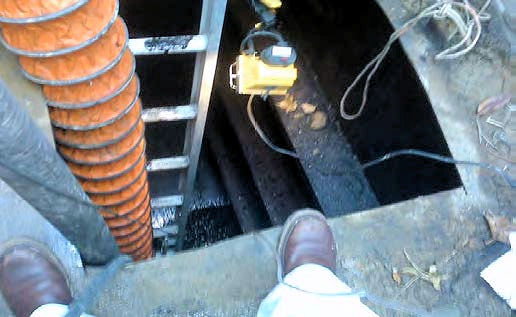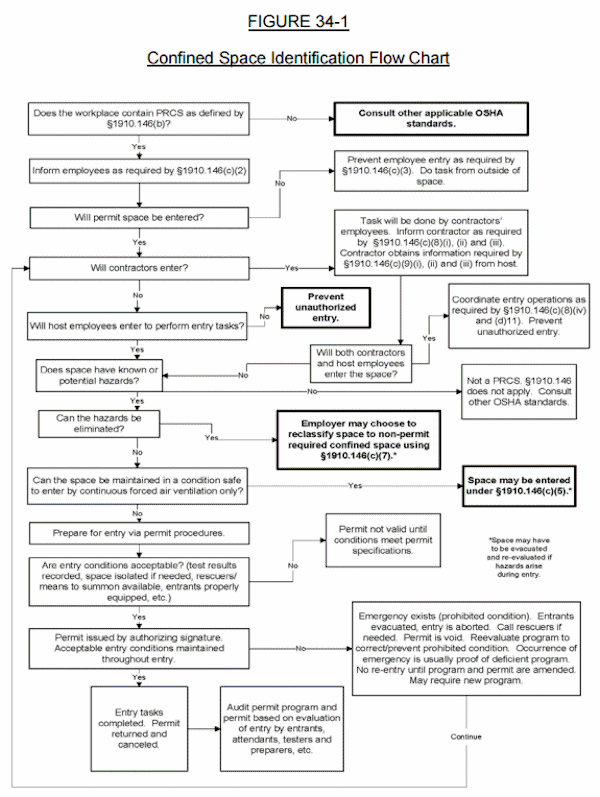SECTION 34 - CONFINED SPACE ENTRY
34.A General.
34.A.01 Confined Spaces - Non-Marine Facilities.
Confined space (CS) work performed in permanent, fixed facilities and/or performed on construction sites must be performed in accordance with this Section, 29 CFR 1910.146 and ANSI Z117.1. This section does not regulate underground construction work (tunneling) as a confined space. > See Section 26.
34.A.02 USACE-conducted CS work activities on or in a watercraft or vessel of any kind and/or associated with vessel repair and maintenance operations are covered in Section 34.B.
34.A.03 The definitions for CS that are applicable to all CSs, during operations, maintenance and construction are listed in Appendix Q, Definitions. (See Definition Below)
Confined space: a space that:
- Is large enough and so configured that a person can bodily enter and perform assigned work; and
- Has limited or restricted means for entry or exit [such that the entrant’s ability to escape in an emergency would be hindered (e.g., tanks, vessels, silos, storage bins, hoppers, vaults, and pits are spaces that may have limited means of entry; doorways are not considered a limited means of entry or egress)]; and
- Is not designed for continuous worker occupancy.
Permit-required confined space (permit space): a confined space that has one or more of the following characteristics:
- Contains or has the potential to contain a hazardous atmosphere,
- Contains a material that has the potential for engulfing an entrant,
- Has an internal configuration such that an entrant could be trapped or asphyxiated by inwardly converging walls or by a floor that slopes downward and tapers to a smaller cross-section, or
- Contains any other recognized serious safety or health hazard.
34.A.04 Confined Space Identification.
Facilities and job sites must assign a Safety Supervisor or Confined Space Competent Person (CSCP) to identify all CSs and determine entry rules and requirements. > See Figure 34-1.
- On USACE facilities, all fixed permit-required CS (PRCS) must be labeled as a PRCS. With the approval of the local Safety Office (SOHO), the CSCP may exclude from labeling those confined spaces that pose little or no hazard, (i.e., a navigation lock), but meet the strict definition of a permit-required confined space (PRCS).
-
On construction sites and/or during O&M activities, all fixed PRCS must be labeled as a danger. PRCS that are created as part of construction work must be labeled and have a barrier to restrict entry.
All Non Permit-Required Confined Spaces (NPRCS) created as part of construction and/or O&M activities are not required to be labeled.
- If activities in a NPRCS (i.e., welding), create or have a potential to create a hazardous atmosphere, that space must be declared a PRCS.
- All previously identified CSs must be identified in writing to any contract personnel prior to the beginning of work if they are required to enter and/or work in this area.
- (1) The contract documents must list any known hazards and controls in the CS.
- (2) If it is known that work to be conducted inside a CS would create a possible hazardous atmosphere, the contractor must be notified prior to beginning work and must be required to follow the requirements for PRCS.
- (3) All entry into an identified or contractor-created PRCS must be coordinated with the GDA and site security or emergency personnel before each entry.
- For work conducted on military installations, the CSCP or designer must coordinate with the installation CS program manager/team to identify all CSs and determine any specific installation requirements for entry.
Knowledge Check Choose the best answer for the question.
34-1. On construction sites and/or during O&M activities, all fixed Permit-Required Confined Spaces (PRCS) must _____.
You forgot to answer the question!


